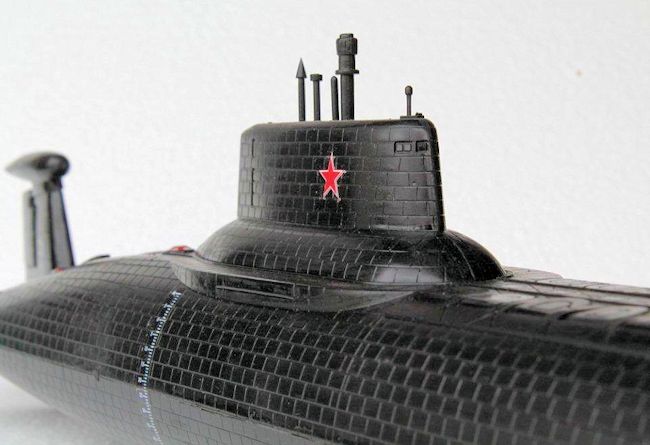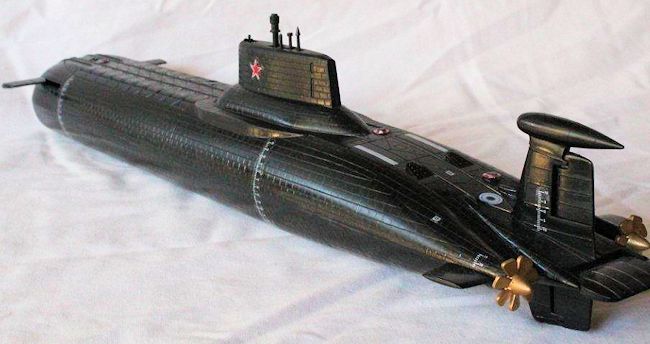
1/400 'Red October' Submarine
| KIT #: | |
| PRICE: | |
| DECALS: | one option |
| REVIEWER: | George Oh |
| NOTES: |
Easy build.
Major omission. |

| HISTORY |
The Project 941 or Akula-class submarine ("Акула" in Russian, meaning ‘shark’.
NATO reporting name: TYPHOON) was a type of nuclear-powered
ballistic missile submarine deployed by the
Soviet Navy in the 1980s. With a submerged
displacement of 48,000 tons, the Typhoons were the largest class of
submarine ever built – and bigger that most WWII aircraft carriers.
They were so large that they had
 decent living facilities for the crew
who may have been submerged for months on end.
Soviet
doctrine for these vessels was to patrol under the Arctic ice cap.
This way, they avoided the need to transit the
GIUK gap and remained safe from enemy
attack submarines and
anti-submarine forces.
They
were able to launch their long-range
missiles with multiple, independently-targeted, nuclear warheads,
though with their range, the missiles could still hit their targets if launched
from a submarine docked in Russia.
The Russian Navy cancelled its Typhoon modernization program in March 2012,
stating that modernizing one Typhoon would be as expensive as building two new
Borei-class
submarines.
With Russia’s
announcement that they’d eliminated the last
SS-N-20 Sturgeon SLBMs in September 2012, the remaining Typhoons
reached the end of their service life.
decent living facilities for the crew
who may have been submerged for months on end.
Soviet
doctrine for these vessels was to patrol under the Arctic ice cap.
This way, they avoided the need to transit the
GIUK gap and remained safe from enemy
attack submarines and
anti-submarine forces.
They
were able to launch their long-range
missiles with multiple, independently-targeted, nuclear warheads,
though with their range, the missiles could still hit their targets if launched
from a submarine docked in Russia.
The Russian Navy cancelled its Typhoon modernization program in March 2012,
stating that modernizing one Typhoon would be as expensive as building two new
Borei-class
submarines.
With Russia’s
announcement that they’d eliminated the last
SS-N-20 Sturgeon SLBMs in September 2012, the remaining Typhoons
reached the end of their service life.
In 1984, Tom Clancy released his book ‘The Hunt for Red October’, about a
Russian Typhoon-class submarine that is stealthy because of its covering of the
anechoic tiles (rubber tiles to impede the reflection of sonar waves), and a
near-silent, magneto/hydrodynamic water propulsion system, aka a
 caterpillar
drive.
In the book, the captain
tells his Fleet HQ that he and his officers are going defect to the USA.
The Russians tell the US that he is nuts and may launch a massive nuclear
strike on the USA.
So, everyone is
out to sink the Red October.
In
1990, it was made into a movie, and Revell released models of the Red October,
and the American Los Angeles-class attack submarine, USS Dallas (which detected
& shadowed the Red October).
My
wife loves the movie, so I bought it, and both models (for her?).
I built the Dallas, that’s another story.
caterpillar
drive.
In the book, the captain
tells his Fleet HQ that he and his officers are going defect to the USA.
The Russians tell the US that he is nuts and may launch a massive nuclear
strike on the USA.
So, everyone is
out to sink the Red October.
In
1990, it was made into a movie, and Revell released models of the Red October,
and the American Los Angeles-class attack submarine, USS Dallas (which detected
& shadowed the Red October).
My
wife loves the movie, so I bought it, and both models (for her?).
I built the Dallas, that’s another story.
Fast-forward to 2012, and cue the scene where the president of my Model Club announced that the theme for our Club’s display at the National modelling competition (Model Expo) was to be ‘By the Book’. Well, I knew that I could supply the book and the USS Dallas; then I blurted-out that I’d supply the Red October, too.
| THE KIT |
 This model came on a long box containing 29 kit parts & a 2-piece stand, all
moulded in black plastic.
The outer
surface has raised moulded-on features.
And it is covered with engraved lines suggesting that the Red October is
made of bricks, but that is merely the representation of the rubber tiles.
This model is able to be built with four
opening missile doors, a raiseable suite of periscopes and a beaver-tail &
rudder control surfaces that are movable way beyond reality.
When I bought this model, I immediately noticed that the visible elements
of the caterpillar drive – specifically the front doors and the rear hatches –
that caused the Red October to be noticed by the CIA, were missing.
So, I planned to scratch-build them.
But, as I was now throwing this together for the display, I discarded the
idea because of time limitations.
This model came on a long box containing 29 kit parts & a 2-piece stand, all
moulded in black plastic.
The outer
surface has raised moulded-on features.
And it is covered with engraved lines suggesting that the Red October is
made of bricks, but that is merely the representation of the rubber tiles.
This model is able to be built with four
opening missile doors, a raiseable suite of periscopes and a beaver-tail &
rudder control surfaces that are movable way beyond reality.
When I bought this model, I immediately noticed that the visible elements
of the caterpillar drive – specifically the front doors and the rear hatches –
that caused the Red October to be noticed by the CIA, were missing.
So, I planned to scratch-build them.
But, as I was now throwing this together for the display, I discarded the
idea because of time limitations.
| CONSTRUCTION |
 airing.
On
real Typhoons, this fairing had a hole at the back – to feed-out the cable of a
towed sonar array, or a radio receiver antenna?
This sub-assembly slotted into the rear of the assembled hull, but I
attached it flush with the upper hull half, and hoped that it’d be OK on the
lower hull half.
The upper hull
also got the fixed forward hydroplanes (but they look like they should be
movable), and I could close the hull, with the bever tail trapped between them.
I thought that the hull seam would be hidden amongst the gaps between the
anechoic tiles, but I was wrong.
And for some reason, there is a separate chin piece that was also hard to blend
into the hull.
As this was just a
display model, I chose to ignore the seams.
airing.
On
real Typhoons, this fairing had a hole at the back – to feed-out the cable of a
towed sonar array, or a radio receiver antenna?
This sub-assembly slotted into the rear of the assembled hull, but I
attached it flush with the upper hull half, and hoped that it’d be OK on the
lower hull half.
The upper hull
also got the fixed forward hydroplanes (but they look like they should be
movable), and I could close the hull, with the bever tail trapped between them.
I thought that the hull seam would be hidden amongst the gaps between the
anechoic tiles, but I was wrong.
And for some reason, there is a separate chin piece that was also hard to blend
into the hull.
As this was just a
display model, I chose to ignore the seams.
The periscope set needed mould seams removed before being trapped between the conning tower halves, and the hull needed internal supports so that the conning tower could be firmly pressed down while the glue set. How come the model designers don’t think about this sort of support for us modellers? The hull got its internal supported from two lengths of sprue that I inserted into holes that I had to drill. Then I attached the conning tower, ensuring that the base of the periscope suite (which would slide down, unseen, into the hull) was untouched by the glue. Now he (all Russian machines are masculine) was ready for painting.
| COLORS & MARKINGS |
In the film, the Red October appears to be black (even when on the surface).
But the instructions suggest a suite of dark greys.
Logic says that the hull should be painted for the rubber anechoic tiles.
I went for the black as per the movie,
and besides – it was the easiest scheme.
As well, I lightly sanded the raised tiles to impart on them a lighter
shade of black (dark grey?).

All that remained was to paint, and to attach the propellers with their
overly-thick blades that I was too lazy to correct by sanding, (waaaay too hard)
and she was done.
The model is
designed so that the propellers will rotate, but they’d have to be trapped
between the hull halves, and that’d make painting them really difficult.
| CONCLUSIONS |
 Accuracy-wise, this is an OK model, because it lacks any representation of the
caterpillar drive.
It is also OK as
a kit because the construction seams are too hard to hide.
Only time & skill beat me on this one.
Other modellers may have more success.
But as a model on your shelf, he is a bigun’ and an unusual shape, to
boot.
On a positive note, our
display “By the Book” was a roaring success.
Accuracy-wise, this is an OK model, because it lacks any representation of the
caterpillar drive.
It is also OK as
a kit because the construction seams are too hard to hide.
Only time & skill beat me on this one.
Other modellers may have more success.
But as a model on your shelf, he is a bigun’ and an unusual shape, to
boot.
On a positive note, our
display “By the Book” was a roaring success.
| REFERENCES |
Just the instructions, the boxart and the movie.
The historical blurb extracted from Wikipedia.
November 2014
Thanks to If you would like your product reviewed fairly and fairly quickly, please contact the editor or see other details in the Note to Contributors.